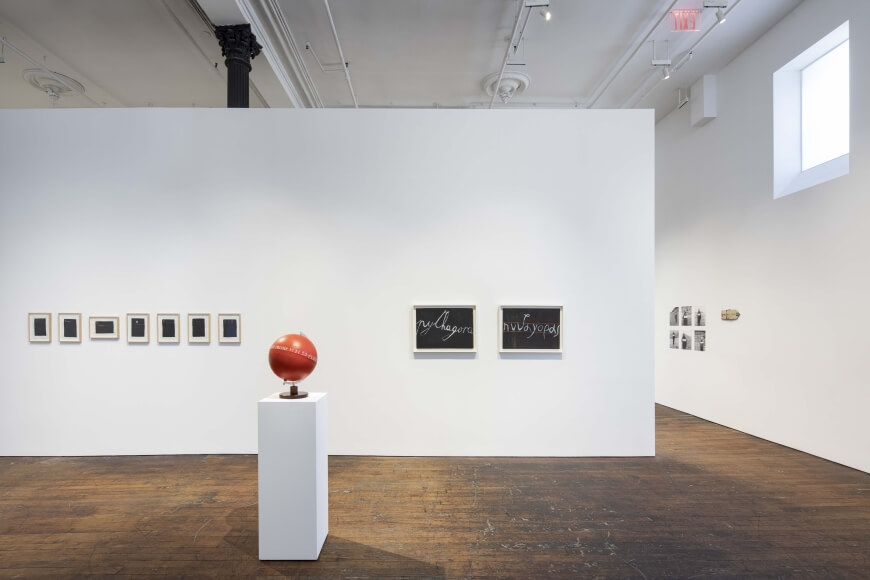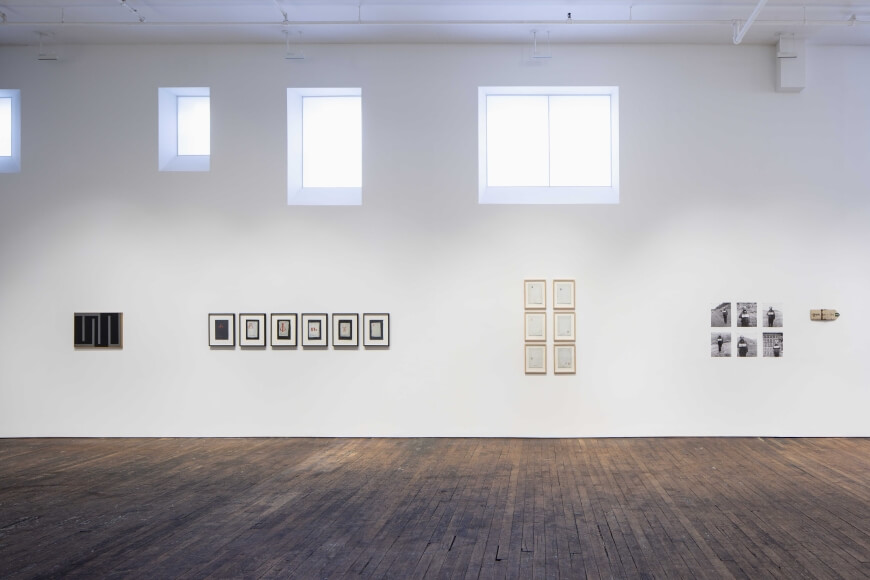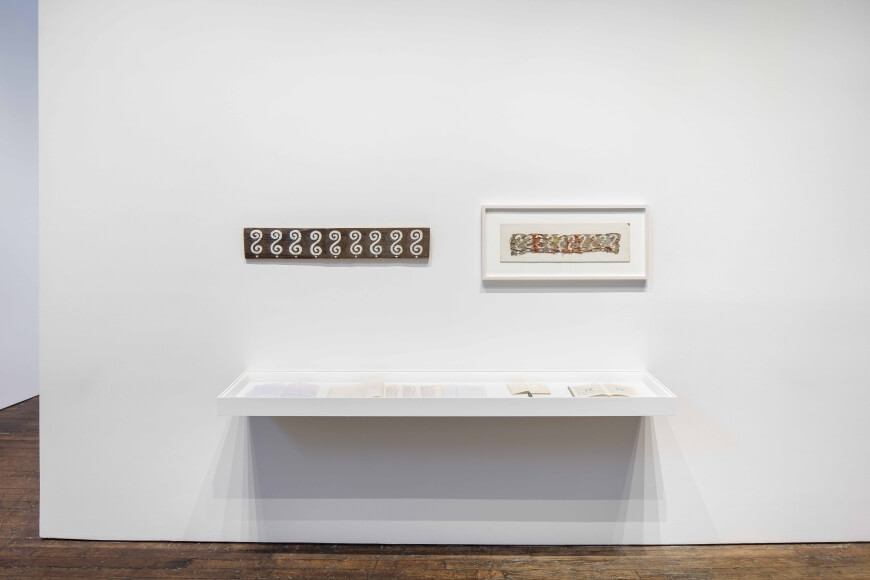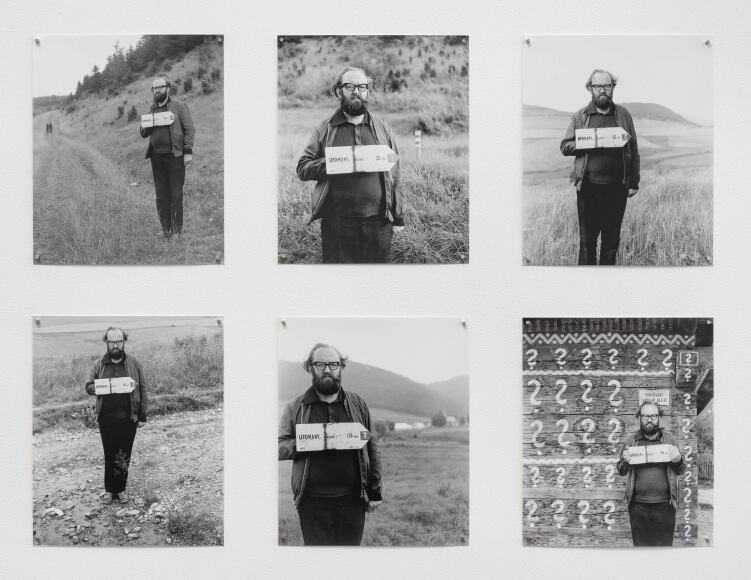V
ý
s
t
a
v
y
From Scratch: Mangelos, Julije Knifer, Július Koller, Mladen Stilinović & Goran Trbuljak
From Scratch: Mangelos, Julije Knifer, Július Koller, Mladen Stilinović & Goran Trbuljak
3. 3. – 16. 4. 2022
Peter Freeman, Inc.,140 Grand Street, New York, NY
curated by Branka Stipančić
From Scratch brings together five artists whose activities were associated with Zagreb and Bratislava – two especially active artistic centres – who incorporated into their work the idea that art should proceed from the basic, elemental, and essential. The exhibition emphasizes the conceptual thread in the works, created between 1949 and 2020, of Mangelos, Julije Knifer, Július Koller, Goran Trbuljak and Mladen Stilinović, in which they foregrounded their distancing from modernism, which they found insufficiently challenging, and their aspiration to find their own artistic positions. The oeuvres of Mangelos, Knifer and Koller were created along the lines of existentialist philosophy and anti-art, striving towards a conceptual practice, and Trbuljak and Stilinović followed somewhat later, when the relations in the artworld had already changed.
Mangelos’s Tabula Rasa is an introduction into the exhibition in which each of the artists finds their way to symbolically „start from the beginning.“ For Mangelos (1921 – 1987), this means „learning the letters“ of the Greek, Latin, Glagolitic and Cyrillic alphabets, runes, and others, and tying them to words. He used to explain that writing on Tabula Rasa was related to the motif of a new beginning, but also to the negation of painting. He sought to „negate the picture by writing it with words, to negate the word by painting it.“ He used words to redirect the process of looking towards thought and function, and away from the emotional. In the 1970s, he wrote a number of manifestos containing his propositions on art and civilization, some of which he also wrote on globes. The exhibited globe entitled Energy, flowing along the equator in different languages and scripts, is a metaphor for the world and its operating forces.
For Julije Knifer (1924 – 2004) – who, like Mangelos, was a member of the neo-avant-garde Gorgona group (active in Zagreb 1959 – 1966) – focusing on what’s essential meant reducing the visual to its basic elements. He believed that by using minimal means and extreme contrasts he could achieve a form of anti-painting. He always painted the same symbol – meander – composed of black and white, vertical and horizontal lines. His work reflects boundless patience and asceticism. Repeating the same motif over and over again from the Gorgona period until his death, he proved himself to be a modern Sisyphus and his early works (1960s) are closer to existentialism than the neo-constructivism of the New Tendencies under whose auspices he started exhibiting.
Július Koller (1939 – 2007) is included in the exhibition primarily for his works featuring question marks, through which he demonstrated his artistic and political positions and his reaction to his country’s socio political instability. Koller worked in completely different circumstances than the other artists in this exhibition. Unlike Yugoslavia – which wasn’t behind the Iron Curtain, which had a more moderate form of communism, where citizens could travel freely to both the East and the West, and which had embraced modernism already in the early 1950s so as to distance itself from the Soviet Union – Czechoslovakia was much more rigid in regard to artistic freedoms. Nevertheless, the neo-avant-garde appeared in exhibitions and artists’s studios as early as mid-1960s. Koller, one of Slovakia’s most radical artists, introduced words into his paintings, and this semantic transformation of the canvas and its conversion into text contained a compelling critique of painting. He developed the idea of „anti-happening“ and „anti-painting“ and wrote manifestos. He started using question marks in 1969, a year after the military had suppressed the Prague Spring. Koller would paint question marks on different materials, on everyday objects, on architecture, he would place them in different locations, and perform them in different ways in nature. For him, the question mark was a universal sign of communication, doubt and uncertainty, a symbol that examined the relationship between the individual and the collective, the relationship with the social situation, and man’s relationship with the cosmos in general.
Goran Trbuljak (1948), a prominent conceptual artist, started his career with street actions in the late 1960s and went on to produce an extensive, nuanced, and intriguing oeuvre. An Artist’s Exercise is a series of works which ironize and reduce to absurdity the idea of artistic skill that is necessary for creating a masterpiece. The artist exercises his eyes and hands by writing dots in school arithmetic notebooks, trying to put them right in the middle of the squares. His other „exercises“ include writing straight parallel lines and the process of copying. The artist exercises as if waiting for a time when he will be ready to make his work in the future, and he’s been practicing this for over forty years.
The artistic work of Mladen Stilinović (1947 – 2016) is largely concerned with the idea of the relationship between ideology and the man who resists it. Stilinović tackled some of the key linguistic, existential and artistic subjects such as work, time, money, power, and particularly pain. He saw pain as opposed to power, but also as a product of power. Like Mangelos, he liked the alphabetical order, and used the dictionary to equate the meaning of all words with the word PAIN, since „you learn the concept of pain with language“ (L.Wittgenstein). The visitor is invited to play the Pain Game in which, however you throw the dice, the result is always the same. Because pain is universal. One of his films is named after a school textbook, Primer 1, 2, 3, in which he asks the audience to read aloud what they see in the film: shop signs, then to compose his poem – which had dissolved into words and letters through the frames, and to connect words and images in a fable in order to reveal the moral.
„The vocabulary“ of Stilinović’s works, and of the other works in this exhibition, is associated with school: reading and writing. Notebooks, books and a globe, geometric elements and rhythms, dots and lines, and the symbol of the question mark all point to learning, repetition, a pursuit of perfection, and perseverance accompanied by the hope of discovering and creating something new, of knowing how to pose the right questions and perhaps find the answers.
Despite being present on the local and, sporadically, from the early 1970s onwards, on the international art scene, their work got its due recognition only much later. Their professional careers began in the early 1990s, following socio-political changes in Eastern Europe, when an interest in artists from this region had emerged. Since then, they’ve regularly shown their work at numerous important exhibitions, biennials, solo and group exhibitions around the world. Gradually, they acquired a reputation, and today their works are part of world famous museum collections such as MoMA, Centre Pompidou, MUMOK, Van Abbemuseum, Tate Modern etc.
https://www.peterfreemaninc.com/exhibitions/from-scratch







